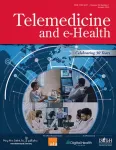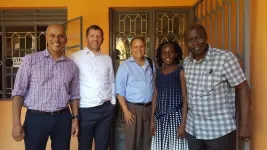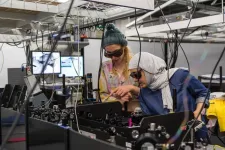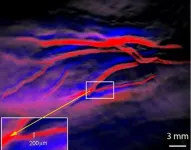(Press-News.org) COLUMBUS, Ohio – The next generation of advanced telescopes could sharpen the hunt for potential extraterrestrial life by closely scrutinizing the atmospheres of nearby exoplanets, new research suggests.
The next generation of advanced telescopes could sharpen the hunt for potential extraterrestrial life by closely scrutinizing the atmospheres of nearby exoplanets, new research suggests.
Published recently in The Astronomical Journal, a new paper details how a team of astronomers from The Ohio State University examined upcoming telescopes’ ability to detect chemical traces of oxygen, carbon dioxide, methane and water on 10 rocky exoplanets. These elements are biosignatures also found in Earth’s atmosphere that can provide key scientific evidence of life.
The study found that for a pair of these nearby worlds, Proxima Centauri b and GJ 887 b, these telescopes are highly adept at detecting the presence of potential biosignatures. Of the two, findings show that only for Proxima Centauri b would the machines be able to detect carbon dioxide if it were present. Though no exoplanet has been found to precisely twin Earth’s early conditions for life, this work suggests that if examined in greater detail, such unique Super Earths – planets more massive than Earth but smaller than Neptune – could make a suitable target for future research missions.
To further the search for habitable planets, Huihao Zhang, lead author of the study and a senior in astronomy at Ohio State, and his colleagues also sought to determine the effectiveness of specialized imaging instruments like the James Webb Space Telescope (JWST) and other Extremely Large Telescopes (ELTs) such as the European Extremely Large Telescope, the Thirty-Meter-Telescope and the Giant Magellan Telescope at directly imaging exoplanets.
“Not every planet is suitable for direct imaging, but that’s why simulations give us a rough idea of what the ELTs would have delivered and the promises they’re meant to hold when they are built,“ said Zhang.
The direct method of imaging exoplanets involves using a coronagraph or starshade to block a host star’s light, allowing for scientists to capture a faint image of the new world in orbit. But because locating them in this way can be difficult and time-consuming, the researchers aimed to see how well the ELT telescopes might handle the challenge. To do this, they tested each telescope’s instruments’ abilities to differentiate universal background noise from the planetary noise they aimed to capture while detecting biosignatures; called the signal-to-noise ratio, the higher it is, the easier a planet’s wavelength is able to be detected and analyzed.
Results showed that the direct imaging mode of one of the European ELT’s instruments, called the Mid-infrared ELT Imager and Spectrograph, performed better for three planets (GJ 887 b, Proxima b and Wolf 1061 c) in discerning the presence of methane, carbon dioxide and water, while its High Angular Resolution Monolithic Optical and Near-infrared Integral field spectrograph instrument could detect methane, carbon dioxide, oxygen and water, but needed a great deal more exposure time.
Additionally, since these conclusions were about instruments that will have to peer through the chemical fog of Earth’s atmosphere to progress the search for cosmic life, they were compared to JWST’s current outer space capabilities, said Zhang.
“It’s hard to say whether space telescopes are better than ground-based telescopes, because they’re different,” he said. “They have different environments, different locations, and their observations have different influences.”
In this case, findings revealed that while GJ 887 b is one of the most suitable targets for ELT direct imaging as its location and size result in an especially high signal-to-noise ratio, for some transiting planets, such as the TRAPPIST-1 system, JWST’s techniques for studying planetary atmospheres are more suitable for detecting them than direct imaging from the ELTs on Earth.
But because the study took on a more conservative assumption with the data, Zhang said, the true effectiveness of future astronomical tools could still surprise scientists. And subtle contrasts in performance aside, these powerful technologies serve to widen our understanding of the universe and are meant to complement each other, said Ji Wang, co-author of the study and an assistant professor in astronomy at Ohio State. It’s why studies like this one, that assess the limitations of those technologies, is necessary, he said.
“The importance of simulation, especially for missions that cost billions of dollars, cannot be stressed enough,” said Wang. “Not only do people have to build the hardware, they also try really hard to simulate the performance and be prepared to achieve those glorious results.”
In all likelihood, as the ELTs won’t be completed until the tail end of the decade, researchers’ next steps will settle around simulating how well future ELT instruments will take to investigating the intricacies of our own planet’s rampant proofs of life.
“We want to see to what extent we can study our atmosphere to exquisite detail and how much information we can extract from it,” said Wang. “Because if we cannot answer habitability questions with Earth’s atmosphere, then there’s no way we can start to answer these questions around other planets.”
This study was supported by the National Science Foundation.
#
Contact: Ji Wang, Wang.12220@osu.edu
Written by: Tatyana Woodall, Woodall.52@osu.edu
END
Researchers spying for signs of life among exoplanet atmospheres
High-tech telescopes search for chemicals necessary for life on Earth
2024-01-29
ELSE PRESS RELEASES FROM THIS DATE:
People are inclined to hide a contagious illness while around others, research shows
2024-01-29
A startling number of people conceal an infectious illness to avoid missing work, travel, or social events, new research at the University of Michigan suggests.
The findings are reported in Psychological Science, a journal of the Association for Psychological Science. Across a series of studies involving healthy and sick adults, 75% of the 4,110 participants said they had either hidden an infectious illness from others at least once or might do so in the future. Many participants reported boarding planes, going on dates, and engaging in other social interactions while secretly sick. More than 61% of healthcare workers participating in the study also ...
Racial and ethnic differences in hypertension-related telehealth
2024-01-29
A new study in the peer-reviewed journal Telemedicine and e-Health found that hypertension management via telehealth increased among Medicaid recipients regardless of race and ethnicity during the COVID-19 pandemic. Click here to read the article now.
Jun Soo Lee, PhD, from the Centers for Disease Control and Prevention (CDC), and coauthors, reported that from February-April 2023, the number of hypertension-related telehealth outpatient visits per 100 persons increased from 0.01 to 6.13, and the number of hypertension-related in-person visits decreased from 61.88 to 52.63.
The investigators ...
Henry Ford Health helps advance precision medicine research in Michigan
2024-01-29
Michiganders will continue to have the opportunity to advance medical research aimed at advancing individualized health care through a renewed award to Henry Ford Health + Michigan State University Health Sciences from the National Institutes of Health’s (NIH) All of Us Research Program. The award includes $18.3 million in initial funding to support a consortium of 8 health care provider organizations with a presence in 16 states.
Henry Ford has led the consortium since 2017. The renewed award allows participation to continue until at least 2028. The multimillion-dollar multi-year award represents the largest NIH research grant in Henry Ford’s 108-year history.
All ...
Jobs and geography may affect hearing: New study maps hearing loss by state and county across the US
2024-01-29
Chicago, IL – January 24, 2024 – The first study to map the prevalence of bilateral hearing loss in the United States by state and county finds that rates of hearing loss are higher among men, non-Hispanic Whites, and residents of rural areas. Bilateral hearing loss is hearing loss in both ears.
West Virginia, Alaska, Wyoming, Oklahoma, and Arizona had the highest rates of hearing loss, while the District of Columbia, New Jersey, New York, Maryland, and Connecticut had the lowest (see top ten highest and ...
UChicago engineer driving key role in Great Lakes water transformation
2024-01-29
The Chicago-based Great Lakes ReNEW coalition has been awarded one of the largest, if not the largest, climate awards in the city’s history – up to $160 million over 10 years as one of the inaugural U.S. National Science Foundation’s Regional Innovation Engines.
Authorized in the “CHIPS and Science Act of 2022,” the NSF Engines program is designed to support the development of diverse regional coalitions of universities, local governments, the private sector and nonprofits to create solutions to today’s pressing issues.
Selected from an initial pool of more ...
Hydroxyurea significantly reduces infections in children with sickle cell anemia
2024-01-29
INDIANAPOLIS -- Clinical research led by Indiana University School of Medicine investigators and their collaborators in Uganda has revealed that hydroxyurea significantly reduces infections in children with sickle cell anemia. Their latest findings enhance strong evidence of hydroxyurea’s effectiveness and could ultimately reduce death in children in Africa, the continent most burdened by the disease.
The group’s research, recently published in the journal Blood, revealed that hydroxyurea treatment resulted in a remarkable ...
University of Manchester and SPIE announce $1 million endowment for postgraduate scholarships
2024-01-29
The University of Manchester and SPIE, the international society for optics and photonics have announced the establishment of the SPIE-Manchester Postgraduate Scholarship in Photonics.
The $500k gift from the SPIE Endowment Matching Program will be matched 100% by the University and will be used to support both early-career and returning researchers from the University’s Photon Science Institute in partnership with the Royce Institute, the UK’s national institute for advanced materials research and innovation.
The partnership was announced today (29 January) during the SPIE Photonics West conference in San Francisco.
Photonics is the study of light and its interactions ...
Argonne scientists help scale up nanomaterials for sustainable manufacturing
2024-01-29
New material is self-assembling, long-lasting and recyclable.
As electronic devices get smaller, the materials needed to create them get smaller as well. Nanoscience is the study of extremely small materials that find uses in energy storage, electronics, health and safety applications and more.
Now a team led by the U.S. Department of Energy’s (DOE) Lawrence Berkeley National Laboratory has developed a new self-assembly method to fabricate multilayered 2D nanosheets. A nanosheet is an extremely small, lasagna-like material made of ultrathin layers of polymers and nanoparticles.
These nanosheets have significantly ...
OU scientists tests revolutionary imaging technique for pancreatic cancer
2024-01-29
Researchers at OU Health Stephenson Cancer Center at the University of Oklahoma Health Sciences have embarked on a revolutionary new research study that could improve the detection of a deadly disease — pancreatic cancer — and give patients a chance to live longer, healthier lives.
The research focuses on an innovative combination of imaging techniques: a newly created contrast agent that recognizes pancreatic cancer cells, paired with Multispectral Optoacoustic Tomography, or MSOT. Together, the approach can detect pancreatic cancer cells the width of an eyelash ...
Rising sea levels could lead to more methane emitted from wetlands
2024-01-29
As sea levels rise due to global warming, ecosystems are being altered. One small silver lining, scientists believed, was that the tidal wetlands found in estuaries might produce less methane – a potent greenhouse gas – as the increasing influx of seawater makes these habitats less hospitable to methane-producing microbes.
However, research from biologists at Lawrence Berkeley National Laboratory (Berkeley Lab) and UC Berkeley indicates that these assumptions aren’t always true. After examining the microbial, chemical, and geological features of 11 wetland zones, the team found that a wetland region exposed ...
LAST 30 PRESS RELEASES:
University of Oklahoma researcher awarded funding to pursue AI-powered material design
Exploring how the visual system recovers following injury
Support for parents with infants at pediatric check-ups leads to better reading and math skills in elementary school
Kids’ behavioral health is a growing share of family health costs
Day & night: Cancer disrupts the brain’s natural rhythm
COVID-19 vaccination significantly reduces risk to pregnant women and baby
The role of vaccination in maternal and perinatal outcomes associated with COVID-19 in pregnancy
Mayo Clinic smartwatch system helps parents shorten and defuse children's severe tantrums early
Behavioral health spending spikes to 40% of all children’s health expenditures, nearly doubling in a decade
Digital cognitive behavioral treatment for generalized anxiety disorder
Expenditures for pediatric behavioral health care over time and estimated family financial burden
Air conditioning in nursing homes and mortality during extreme heat
The Alps to lose a record number of glaciers in the next decade
What makes a good proton conductor?
New science reporting guide published for journalists in Bulgaria
New international study reveals major survival gaps among children with cancer
New science reporting guide published for journalists in Turkey
Scientists develop a smarter mRNA therapy that knows which cells to target
Neuroanatomy-informed brain–machine hybrid intelligence for robust acoustic target detection
Eight SwRI hydrogen projects funded by ENERGYWERX
The Lundquist Institute and its start-up company Vitalex Biosciences Announces Strategic Advancement of Second-Generation fungal Vaccine VXV-01 through Phase 1 Trials under $40 Million Competitive Con
Fine particles in pollution are associated with early signs of autoimmune disease
Review article | Towards a Global Ground-Based Earth Observatory (GGBEO): Leveraging existing systems and networks
Penn and UMich create world’s smallest programmable, autonomous robots
Cleveland researchers launch first major study to address ‘hidden performance killer’ in athletes
To connect across politics, try saying what you oppose
Modulating key interaction prevents virus from entering cells
Project explores barriers to NHS career progression facing international medical graduates
Jeonbuk National University researchers explore the impact of different seasonings on the flavor perception of Doenjang soup
Two Keck Medicine of USC Hospitals named Leapfrog Top Teaching Hospitals
[Press-News.org] Researchers spying for signs of life among exoplanet atmospheresHigh-tech telescopes search for chemicals necessary for life on Earth







